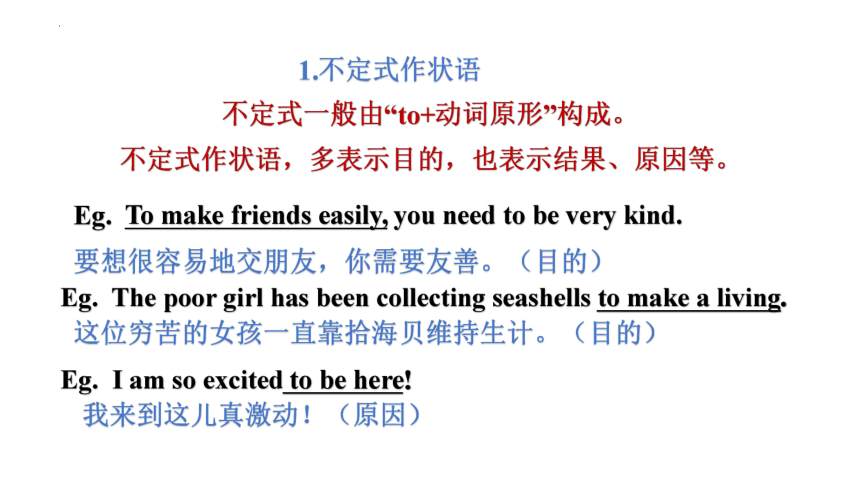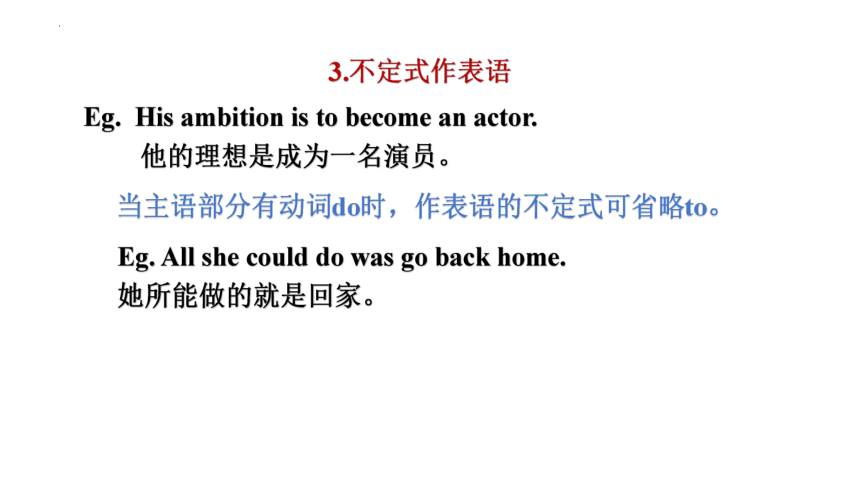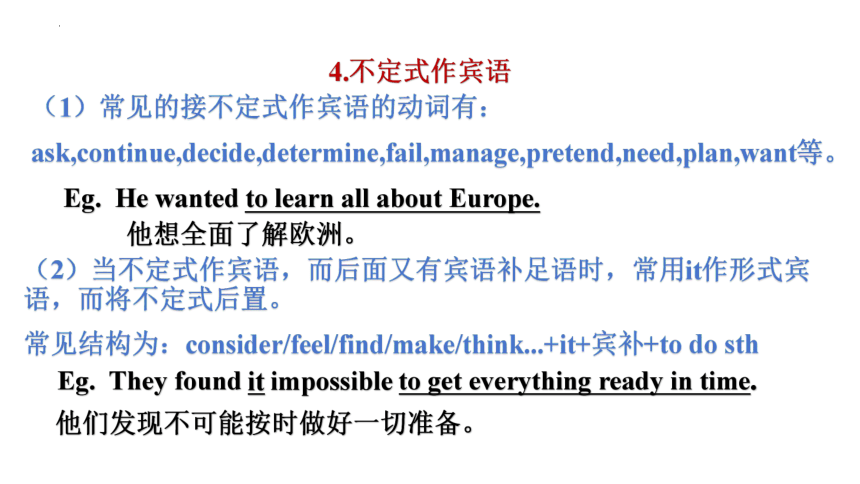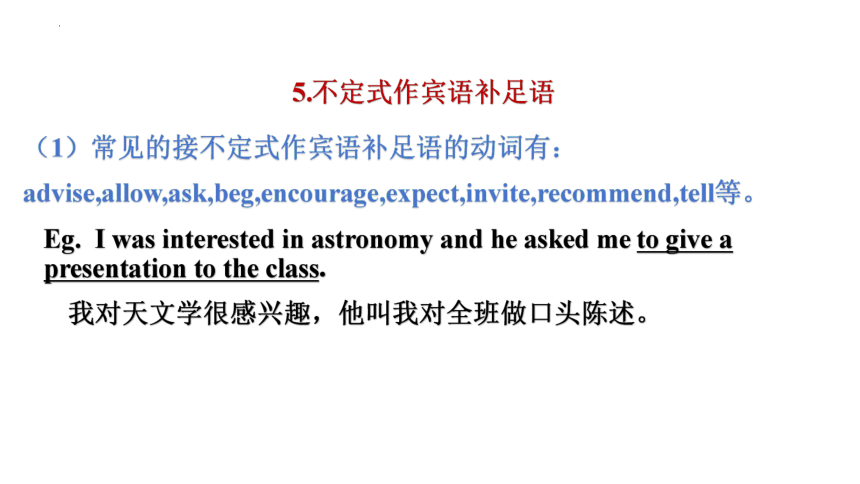人教版(2019)必修 第一册Unit 3 Sports and fitness语法知识点课件(共18张ppt)
文档属性
| 名称 | 人教版(2019)必修 第一册Unit 3 Sports and fitness语法知识点课件(共18张ppt) |  | |
| 格式 | pptx | ||
| 文件大小 | 255.3KB | ||
| 资源类型 | 教案 | ||
| 版本资源 | 人教版(2019) | ||
| 科目 | 英语 | ||
| 更新时间 | 2023-10-08 22:46:59 | ||
图片预览







文档简介
(共18张PPT)
1.不定式作状语
Eg. To make friends easily, you need to be very kind.
要想很容易地交朋友,你需要友善。(目的)
Eg. The poor girl has been collecting seashells to make a living.
这位穷苦的女孩一直靠拾海贝维持生计。(目的)
Eg. I am so excited to be here!
我来到这儿真激动!(原因)
不定式一般由“to+动词原形”构成。
不定式作状语,多表示目的,也表示结果、原因等。
___________(learn) more about Chinese culture, Jack has decided to take Chinese folk music(民俗音乐) as an elective course.
To learn
This machine is very easy _________ (operate). Anybody can learn to use it in a few minutes.
to operate
Tom took a taxi to the airport, only __________(find) his plane high up in the sky.
to find
不定式作目的状语。
不定式可用在作表语的形容词后面作状语。
不定式与only连用作结果状语,表示一种意外的结果。
PRACTICE
2.不定式作主语
Eg. To see is to believe.
眼见为实。
Eg. To climb the mountain road was hard work but to go down the hills was great fun.
上山很艰难,而下山却很好玩。
在很多情况下,常用it作形式主语,而把不定式移至句末,以保持句子平衡。
Eg. It is not easy to find your way around the town.
在这个小镇要找到路很不容易。
3.不定式作表语
Eg. His ambition is to become an actor.
他的理想是成为一名演员。
当主语部分有动词do时,作表语的不定式可省略to。
Eg. All she could do was go back home.
她所能做的就是回家。
4.不定式作宾语
Eg. He wanted to learn all about Europe.
他想全面了解欧洲。
(1)常见的接不定式作宾语的动词有:
ask,continue,decide,determine,fail,manage,pretend,need,plan,want等。
(2)当不定式作宾语,而后面又有宾语补足语时,常用it作形式宾语,而将不定式后置。
常见结构为:consider/feel/find/make/think...+it+宾补+to do sth
Eg. They found it impossible to get everything ready in time.
他们发现不可能按时做好一切准备。
5.不定式作宾语补足语
Eg. I was interested in astronomy and he asked me to give a presentation to the class.
(1)常见的接不定式作宾语补足语的动词有:
advise,allow,ask,beg,encourage,expect,invite,recommend,tell等。
我对天文学很感兴趣,他叫我对全班做口头陈述。
注意:当make用于被动语态时,作宾补的不定式要带to。
(2)有些感官动词和使役动词接不定式作宾补时,通常不带to。
四看: see, watch, notice, observe
三使役: let, have, make
二听: hear, listen to
一感觉: feel
Eg. Tom doesn’t have to be made to learn.
不必强迫汤姆学习。
Eg. They made me wait while they checked everyone’s air tickets.
他们检查所有人的机票而让我等着。
6.不定式作定语
Eg. I am always the first person to get to the office.
(1)不定式作定语一般与所修饰的名词构成主谓关系、动宾关系、同位关系或偏正关系。
我总是第一个到办公室的人。(主谓关系)
Eg. There are lots of interesting things to see there.
那里有许多有趣的东西可看。(动宾关系)
Eg. There are many ways to make people laugh.
有很多方法逗人们笑。(偏正关系)
6.不定式作定语
Eg. The meeting to be held tomorrow is of great importance.
(2)不定式作定语时,多表示将来的动作。
明天要召开的会议非常重要。
PRACTICE
1.David threatened _______________ (report) his neighbour to the police if the damages
to report
2.The two girls are so alike that strangers find ____________ difficult to tell one from the other.
3.He allowed me ________(stay) and watch.
4.The director had her assistant ________(pick) up some hot gods for the meeting.
5. Birds’ singing is sometimes a warning to other birds ___________(stay) away.
6.If there is a lot of work _____________(do), I’m happy to just keep on until it is finished.
7.—The last one _________(arrive) pays the meal.
—Agreed!
8. We are invited to a party _________(hold) in our club next Friday.
it
to stay
pick
have sb. do sth.
让某人做某事
to stay
to do
to arrive
to be held
1.since后接表示过去的时间,或一般过去时态的状语从句时,主句要用现在完成时或者现在完成进行时。
I have been here since 2015.
I haven’t seen her since last week.
She has been cooking since 5 o’clock.
自上周以来,我一直未见过她。
我从2015年就在这里了。
她从五点钟就一直在做饭。
2.ever since 意为“从...之后一直”,与完成时连用。后可接名词、短语或从句,需要注意的是:从句用一般过去时,主句用现在完成时或者现在完成进行时。
He has lived there ever since he went to Tibet in 1969 .
自从他1969年去了西藏以来,他就一直住在那里。
3.It is / has been +时间段 +since +一般过去时态。
It is/has been 10 years since she left.
自从她离开以后已经十年了。
I _______ in the city since I left school.
A.live B.will live C.was living D.have lived
D.
It’s ten years since we _______(come) here.
came
—The local railway station was closed in 2012, wasn’t it
—Yes, and our village _______ cut off ever since.
A. is B. was C. has been D. had been
C
疑问词+do you think +陈述语序
do you think 是插入语,插入语并不影响句子主旨意思的表达。
特殊疑问句由特殊疑问词加一般疑问句句式构成。
但当do you think 作为插入语,它会改变后面一般疑问句句式的结构。
要由一般疑问句式变为陈述句语序。
也就是说要把助动词或情态动词还原回主语之后。
当特殊疑问词在疑问句中做主语时,有无插入语(do you think),语序均不发生改变。
When do you think _________________
A.will he be back B.he will be back
C.will be he back D.he will back
B
What do you think will happen next
你认为下一步将发生什么?
Who do you think will win the first price
你认为谁将赢得一等奖?
找准助动词
So放句首
主语在最后
so+助动词/情态动词/be 动词+另一主语
so:也这样、也是如此(肯定)
Eg. A: I’ve got some small change(零钱).
B: So have I.
A和B说话的人不同
Eg. A: I live in Beijing.
B: So does Tom.
I have got some small change, too.
Tom lives in Beijing, too.
Eg. A: He works hard.
B: So he does.
Eg. A: She likes sports.
B: So she does.
A和B说话的主语一样时,so只是起加强语气的作用。
意为:...的确是这样.
Eg. A: I don’t like chicken.
B: Neither do I.
Eg. A: I never get up early on Sundays.
B: Neither does Michael.
neither/nor+助动词/情态动词/be 动词+另一主语
neither/nor:也不是(否定)
I don’t like chicken, either.
Michael never gets up early on Sundays either.
—People in England rest two days a week.
—________________________.
A.So Chinese are B. So are Chinese
C.So do Chinese D.So Chinese do
C
1.不定式作状语
Eg. To make friends easily, you need to be very kind.
要想很容易地交朋友,你需要友善。(目的)
Eg. The poor girl has been collecting seashells to make a living.
这位穷苦的女孩一直靠拾海贝维持生计。(目的)
Eg. I am so excited to be here!
我来到这儿真激动!(原因)
不定式一般由“to+动词原形”构成。
不定式作状语,多表示目的,也表示结果、原因等。
___________(learn) more about Chinese culture, Jack has decided to take Chinese folk music(民俗音乐) as an elective course.
To learn
This machine is very easy _________ (operate). Anybody can learn to use it in a few minutes.
to operate
Tom took a taxi to the airport, only __________(find) his plane high up in the sky.
to find
不定式作目的状语。
不定式可用在作表语的形容词后面作状语。
不定式与only连用作结果状语,表示一种意外的结果。
PRACTICE
2.不定式作主语
Eg. To see is to believe.
眼见为实。
Eg. To climb the mountain road was hard work but to go down the hills was great fun.
上山很艰难,而下山却很好玩。
在很多情况下,常用it作形式主语,而把不定式移至句末,以保持句子平衡。
Eg. It is not easy to find your way around the town.
在这个小镇要找到路很不容易。
3.不定式作表语
Eg. His ambition is to become an actor.
他的理想是成为一名演员。
当主语部分有动词do时,作表语的不定式可省略to。
Eg. All she could do was go back home.
她所能做的就是回家。
4.不定式作宾语
Eg. He wanted to learn all about Europe.
他想全面了解欧洲。
(1)常见的接不定式作宾语的动词有:
ask,continue,decide,determine,fail,manage,pretend,need,plan,want等。
(2)当不定式作宾语,而后面又有宾语补足语时,常用it作形式宾语,而将不定式后置。
常见结构为:consider/feel/find/make/think...+it+宾补+to do sth
Eg. They found it impossible to get everything ready in time.
他们发现不可能按时做好一切准备。
5.不定式作宾语补足语
Eg. I was interested in astronomy and he asked me to give a presentation to the class.
(1)常见的接不定式作宾语补足语的动词有:
advise,allow,ask,beg,encourage,expect,invite,recommend,tell等。
我对天文学很感兴趣,他叫我对全班做口头陈述。
注意:当make用于被动语态时,作宾补的不定式要带to。
(2)有些感官动词和使役动词接不定式作宾补时,通常不带to。
四看: see, watch, notice, observe
三使役: let, have, make
二听: hear, listen to
一感觉: feel
Eg. Tom doesn’t have to be made to learn.
不必强迫汤姆学习。
Eg. They made me wait while they checked everyone’s air tickets.
他们检查所有人的机票而让我等着。
6.不定式作定语
Eg. I am always the first person to get to the office.
(1)不定式作定语一般与所修饰的名词构成主谓关系、动宾关系、同位关系或偏正关系。
我总是第一个到办公室的人。(主谓关系)
Eg. There are lots of interesting things to see there.
那里有许多有趣的东西可看。(动宾关系)
Eg. There are many ways to make people laugh.
有很多方法逗人们笑。(偏正关系)
6.不定式作定语
Eg. The meeting to be held tomorrow is of great importance.
(2)不定式作定语时,多表示将来的动作。
明天要召开的会议非常重要。
PRACTICE
1.David threatened _______________ (report) his neighbour to the police if the damages
to report
2.The two girls are so alike that strangers find ____________ difficult to tell one from the other.
3.He allowed me ________(stay) and watch.
4.The director had her assistant ________(pick) up some hot gods for the meeting.
5. Birds’ singing is sometimes a warning to other birds ___________(stay) away.
6.If there is a lot of work _____________(do), I’m happy to just keep on until it is finished.
7.—The last one _________(arrive) pays the meal.
—Agreed!
8. We are invited to a party _________(hold) in our club next Friday.
it
to stay
pick
have sb. do sth.
让某人做某事
to stay
to do
to arrive
to be held
1.since后接表示过去的时间,或一般过去时态的状语从句时,主句要用现在完成时或者现在完成进行时。
I have been here since 2015.
I haven’t seen her since last week.
She has been cooking since 5 o’clock.
自上周以来,我一直未见过她。
我从2015年就在这里了。
她从五点钟就一直在做饭。
2.ever since 意为“从...之后一直”,与完成时连用。后可接名词、短语或从句,需要注意的是:从句用一般过去时,主句用现在完成时或者现在完成进行时。
He has lived there ever since he went to Tibet in 1969 .
自从他1969年去了西藏以来,他就一直住在那里。
3.It is / has been +时间段 +since +一般过去时态。
It is/has been 10 years since she left.
自从她离开以后已经十年了。
I _______ in the city since I left school.
A.live B.will live C.was living D.have lived
D.
It’s ten years since we _______(come) here.
came
—The local railway station was closed in 2012, wasn’t it
—Yes, and our village _______ cut off ever since.
A. is B. was C. has been D. had been
C
疑问词+do you think +陈述语序
do you think 是插入语,插入语并不影响句子主旨意思的表达。
特殊疑问句由特殊疑问词加一般疑问句句式构成。
但当do you think 作为插入语,它会改变后面一般疑问句句式的结构。
要由一般疑问句式变为陈述句语序。
也就是说要把助动词或情态动词还原回主语之后。
当特殊疑问词在疑问句中做主语时,有无插入语(do you think),语序均不发生改变。
When do you think _________________
A.will he be back B.he will be back
C.will be he back D.he will back
B
What do you think will happen next
你认为下一步将发生什么?
Who do you think will win the first price
你认为谁将赢得一等奖?
找准助动词
So放句首
主语在最后
so+助动词/情态动词/be 动词+另一主语
so:也这样、也是如此(肯定)
Eg. A: I’ve got some small change(零钱).
B: So have I.
A和B说话的人不同
Eg. A: I live in Beijing.
B: So does Tom.
I have got some small change, too.
Tom lives in Beijing, too.
Eg. A: He works hard.
B: So he does.
Eg. A: She likes sports.
B: So she does.
A和B说话的主语一样时,so只是起加强语气的作用。
意为:...的确是这样.
Eg. A: I don’t like chicken.
B: Neither do I.
Eg. A: I never get up early on Sundays.
B: Neither does Michael.
neither/nor+助动词/情态动词/be 动词+另一主语
neither/nor:也不是(否定)
I don’t like chicken, either.
Michael never gets up early on Sundays either.
—People in England rest two days a week.
—________________________.
A.So Chinese are B. So are Chinese
C.So do Chinese D.So Chinese do
C
